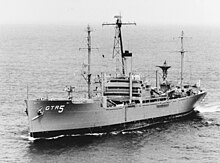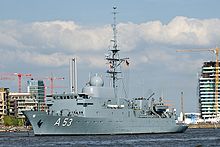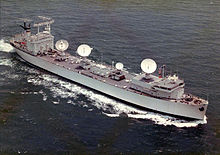The United States Navy, United States Coast Guard, and United States National Oceanic and Atmospheric Administration (NOAA) use a hull classification symbol to identify their ships by type and by individual ship within a type. The system is analogous to the pennant number system that the Royal Navy and other European and Commonwealth navies use.

USS Halibut (SSGN-587), a unique nuclear-powered guided missile submarine-turned-special operations platform, later redesignated as an attack submarine SSN-587, was the second ship of the United States Navy to be named after the halibut.

A cruise missile submarine is a submarine that carries and launches cruise missiles as its primary armament. Missiles greatly enhance a warship's ability to attack surface combatants and strike land targets; although torpedoes are a more discrete option for submerged submarines, missiles give a much longer stand-off range, shorter time to impact the target, as well as the ability to engage multiple targets on different headings at the same time. Many cruise missile submarines retain the capability to deploy nuclear warheads on their missiles, but they are considered distinct from ballistic missile submarines due to the substantial differences between the two weapons systems' flight characteristics; cruise missiles fly aerodynamically using flight surfaces like wings or fins, while a ballistic missile uses its engine power alone as it may exit the atmosphere.

USS Parche (SSN-683), a Sturgeon-class submarine, was the second ship of the United States Navy to be named for the parche, a small, coral reef butterfly fish. Parche was launched on 13 January 1973, sponsored by Natalie Beshany, the wife of Vice Admiral Philip A. Beshany, and commissioned on 17 August 1974.
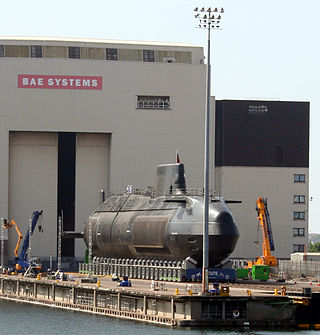
A nuclear submarine is a submarine powered by a nuclear reactor, but not necessarily nuclear-armed. Nuclear submarines have considerable performance advantages over "conventional" submarines. Nuclear propulsion, being completely independent of air, frees the submarine from the need to surface frequently, as is necessary for conventional submarines. The large amount of power generated by a nuclear reactor allows nuclear submarines to operate at high speed for long periods, and the long interval between refuelings grants a range virtually unlimited, making the only limits on voyage times being imposed by such factors as the need to restock food or other consumables.
The Rim of the Pacific Exercise (RIMPAC) is the world's largest international maritime warfare exercise. RIMPAC is held biennially during June and July of even-numbered years from Honolulu, Hawaii, with the exception of 2020 where it was held in August. It is hosted and administered by the United States Navy's Indo-Pacific Command, headquartered at Pearl Harbor, in conjunction with the Marine Corps, the Coast Guard, and Hawaii National Guard forces under the control of the Governor of Hawaii.
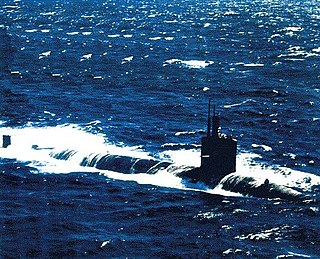
USS Batfish (SSN-681), was a nuclear-powered attack submarine of the United States Navy. She was the eleventh Sturgeon-class submarine launched. Her primary missions were anti-submarine warfare, intelligence gathering, and screening carrier battle groups. She was launched in 1971 and decommissioned in 1999.

The Echo class were nuclear cruise missile submarines of the Soviet Navy built during the 1960s. Their Soviet designation was Project 659 for the first five vessels, and Project 675 for the following twenty-nine. Their NATO reporting names were Echo I and Echo II. All were decommissioned by 1994.

Anti-submarine warfare is a branch of underwater warfare that uses surface warships, aircraft, submarines, or other platforms, to find, track, and deter, damage, or destroy enemy submarines. Such operations are typically carried out to protect friendly shipping and coastal facilities from submarine attacks and to overcome blockades.

USNS Observation Island (T-AGM-23) was built as the Mariner-class merchant ship Empire State Mariner for the United States Maritime Commission, launched 15 August 1953, and operated by United States Lines upon delivery on 24 February 1954, making voyages for the Military Sea Transportation Service (MSTS) until going into reserve at Mobile, Alabama on 9 November 1954.

USNS Invincible (T-AGM-24), also known as ex-AGOS 10, is one of two tracking ships operated by the Military Sealift Command. One of the radars it carries is the Cobra Gemini dual band, X band and S band, radar.

HMNZS Waikato (F55) was a Leander Batch 2TA frigate of the Royal New Zealand Navy (RNZN). She was one of two Leanders built for the RNZN, the other being the Batch 3 HMNZS Canterbury. These two New Zealand ships relieved British ships of the Armilla patrol during the Falklands conflict, freeing British ships for deployment.

Naval trawlers are vessels built along the lines of a fishing trawler but fitted out for naval purposes; they were widely used during the First and Second World Wars. Some—known in the Royal Navy as "Admiralty trawlers"— were purpose-built to naval specifications, others adapted from civilian use. Fishing trawlers were particularly suited for many naval requirements because they were robust vessels designed to work heavy trawls in all types of weather, and had large clear working decks. A minesweeper could be created by replacing the trawl with a mine sweep. Adding depth charge racks on the deck, ASDIC sonar below, and a 3-inch (76 mm) or 4-inch (102 mm) gun in the bow equipped the trawler for anti-submarine duties.

The Balzam class, Soviet designation Project 1826 is a class of intelligence collection ships built in the Soviet Union for the Soviet Navy during the 1980s. They are also known as Lira class, after the first vessel of the class.

Zadornyy was a Project 1135 Burevestnik-class guard ship or Krivak-class frigate that served with the Soviet and Russian Navies. Displacing 3,200 tonnes full load, the vessel was built around the Metel anti-submarine missile system. Zadornyy was launched on 25 March 1979 in Leningrad, the last of the class to be built by the A.A. Zhdanov shipyard, and served with the Northern Fleet. After taking part in exercises Avangard-81, Sever-81 and Okean-83, and cruising as far as Havana, Cuba, the vessel was upgraded between 11 June 1990 and 23 May 1995 with missiles that added anti-ship capability. While serving with the Russian Navy, the ship took part in joint exercises with frigates of the Royal Navy, including a commemoration of the first Arctic convoy of the Second World War with HMS Campbeltown. After more than twenty-five years service, the ship was decommissioned on 3 December 2005.

Rezkiy was a Project 1135M large anti-submarine ship or Krivak-class frigate of the Soviet Navy. With an armament based around the URPK-4 Metel anti-submarine missile system, the vessel was launched on 17 February 1975. Joining the Pacific Fleet on 2 February the following year, the ship operated primarily in the Indian Ocean, including visits to Ethiopia, India and Mauritius. The vessel was also involved in tracking the cruisers USS Arkansas and USS Fox, as well as searching for a submarine that crossed the Soviet anti-submarine barrier in 1980. In 1981, the vessel sailed as part of a task force along the west coast of the United States to test and measure American defences. After the dissolution of the Soviet Union, the ship joined the Russian Navy. Later that decade, the vessel was rearmed with the URPK-5 Rastrub which provided greater anti-ship capability to the vessel. After nearly twenty years in service, 4 August 1995, Rezkiy was decommissioned and subsequently broken up.

Razyashchiy was a Project 1135 Burevestnik-class Large Anti-Submarine Ship or Krivak-class frigate of the Soviet Navy. Displacing 3,200 tonnes full load, the vessel was built around the Metel anti-submarine missile system. Launched on 22 July 1974, Razyashchiy joined the Pacific Fleet of the Soviet Navy. While serving in the Arabian Sea, in 1983, Razyashchiy suffered minor hull damage from colliding with the destroyer USS Fife while approaching a US fleet. The ship also undertook visits to Port Louis, Mauritius, and Danang, Vietnam, to, among other objectives, enhance the relationships between these countries and the Soviet Union. In 1991, the vessel was transferred to the newly-formed Russian Navy. After nearly twenty years of service, however, Razyashchiy was in a poor state and so was decommissioned on 29 October 1992 and sold to be broken up on 6 October 1994.
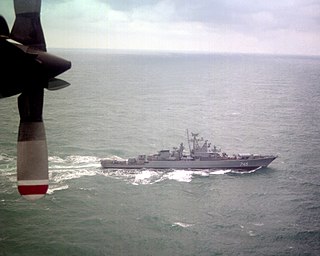
Silnyy or Silny was a Soviet Navy Project 1135 Burevestnik-class Large Anti-Submarine Ship or Krivak-class frigate. Displacing 3,200 tonnes full load, the vessel was built around the Metel anti-submarine missile system. Launched on 29 August 1972, Silnyy served with the Baltic Fleet. The vessel undertook a number of visits to nations friendly to the Soviet Union, including Cape Verde, Cuba, East Germany and Poland. In 1976, while escorting the aircraft carrier Kiev, the ship had a close encounter with the cruiser USS Josephus Daniels, although neither vessel was damaged. Silnyy was taken out of service for repairs in 1990. However, lack of funds meant that, instead, the ship was decommissioned on 30 June 1994 and broken up.
